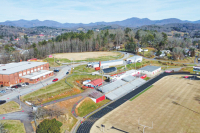Exploring Sylva’s secret garden
Jay Coward is no stranger to Pinnacle Park.
When the work day ends, Coward often trades in his attorney’s suit and tie for hiking attire and escapes into the 1,000-acre wilderness at Sylva’s doorstep. An intergral player with the Pinnacle Park Foundation since the early ‘90s, Coward notices every spiderwort bloom, every bit of trash and every burgeoning erosion issue in the forest. Hiking with Coward, you begin to understand why so many longtime Sylva residents have put so much work into keeping it wild. He first visited the Fisher Creek watershed on a church retreat as a young boy.
“This is one of the most beautiful places in the world, I think,” Coward said. “It’s got two of the most beautiful peaks in the Southern Appalachians –– the Pinnacle and Black Rock.”
With the preserve safe from development in perpetuity as a result of a 2006 conservation agreement, the question these days is how to get it ready to deal with more people as discovery of the secret enclave is inevitable.
The History
Pinnacle Park is a 1,000-acre tract, bounded by steep ridges, that drains the east and west forks of Fisher Creek. The creek was dammed up and served as the source of Sylva’s drinking water.
Related Items
During a period of prolonged drought in the mid-‘80s, the watershed failed to meet the town’s needs, which were also expanding.
At one point, things got so bad that National Guard tankers were forced to deliver water to the hospital. The crisis led to the mothballing of the old watershed in 1992 and the creation of the Tuckaseigee Water & Sewer Authority, which now pulls drinking water from the river.
The same scenario played out in Bryson City, Canton and Murphy, as small watersheds were no longer able to support water demands of their growing populations during drought seasons.
Bill Gibson, the head of Region A at the Southwestern Planning Commission, was watching closely, fearing what may happen to the vast tracts now that they were no longer needed as a source for drinking water.
Gibson said he first heard the idea of preserving Sylva’s old watershed from Tom Massie, who was assistant county manager for Jackson County at the time. Massie and Sylva Mayor Brenda Oliver were behind the push to save the watershed from logging or development.
That same year, 1992, the town of Sylva passed a resolution to preserve the area for conservation, preservation, and recreation. But Coward wanted more certainty than a verbal pledge that could be reversed by the next slate of elected leaders.
“We really needed more than just a resolution,” Coward said. “Because we knew the board might not get re-elected.”
Coward worked with Gibson and others to form a broad-based board of directors for a new nonprofit, The Pinnacle Park Foundation, and they leased the watershed from the town for 25 years, ensuring a new town board couldn’t come in and overturn the policy of preservation.
But the concern persisted that future town leaders would see the old watershed as an asset to be exploited. Some people wanted to log it. Others saw it as a property ripe for development. As a town commissioner at that time, current Sylva Mayor Maurice Moody said the town needed to get more out of it than a nice view.
Those arguments came to a head in 2005, and the town contracted Peter Bates, a forestry professor at Western Carolina University, to survey the property and determine its value. Bates’ team spent the better part of the year studying the old watershed. It found that while there were a few stands of good timber, the area was so steep and inaccessible that it would cost more to log than it would yield.
“Based on that opinion from him, the whole idea of logging went away,” Coward said. “Plus by that time, we had significant enough ammunition to go to the town board and say, ‘Let’s get a conservation easement.’”
In 2006, with the assistance of the Land Trust for the Little Tennessee, Sylva entered a conservation agreement that would permanently restrict development and logging and keep it wild forever. The Clean Water Management Trust Fund gave the town $3.5 million in exchange.
“It was a sustained feeling and policy. A sustained set of ideals that transcended people and changes in the board. It never died,” Gibson said of the movement.
The Park
“The idea of having a park like this is a pretty unique thing for a little town,” Coward said.
Most towns don’t have the resources to deal with a 1,000 acres of wild green space. Pinnacle Park is a steep, rocky piece of land traversed by two old logging roads. One road travels along the west fork of Fisher Creek toward the ridgeline and Pinnacle Peak; the other follows the east fork up toward Black Rock and a rough trail that continues on to Waterrock Knob via the old foxhunter’s camp.
Both of the old roads — which are now foot trails — are gateways to tremendous tracts of public land, full of beautiful views and waterfalls, but they’re also very, very steep. Some stretches have a slope of 70 percent, poor for walking and worse for erosion control.
Ever since the Pinnacle Park Foundation was formed, it has had the challenge of maintaining and developing its trail system. The town has helped and so have civic organizations like the Rotary Club and the Boy Scouts, but much of the effort has been undertaken by Coward, who walks the land like a protective parent.
“Every long movement has to have one really pugnacious, patient guy who will do the same things over and over again,” Coward said.
On a recent trip to the park, Coward pointed out recent developments on the trail system’s lower section, which weaves in and around the old dam that anchored the watershed.
The trails in that part of the park, which Coward said are close to being considered handicap accessible recreation trails, were opened with help from the Rotary Club in 1999.
Last year, the town contributed $25,000 to the park. The money went to improve the parking area, which was severely undersized and inadequate; build footers for bridges over the creek; and create a more robust system of sediment control on the old logging road that is the principal path in the park.
As Coward crossed the creek, he spotted a Busch Lite box at the edge of a deep pool. He scrambled down the bank, retrieved it and told a story about the pool.
“One of the residents nearby came to me and said, ‘I saw naked people swimming around in there,’” Coward said. “And I said, ‘What’s wrong with that?’”
The man scratched his head.
Pinnacle Park is more open and accessible than it’s ever been before, but it’s still underdeveloped. Erosion and kudzu are ever-present concerns. The lower trail system needs four bridges before it provides real accessibility for people who won’t be able to enjoy the upper reaches of the park.
Meanwhile trail signage is limited, the park lacks an official map, and its main thoroughfares are too steep for most people.
But for Coward, the hard part of the battle has been won already.
“I think the philosophical achievement is just to set the example of what you can do. You can preserve a wilderness area. We did,” he said.
The Future
Too many people have put too much work into Pinnacle Park for it to remain inhospitable to the public.
At the same time, the wildness of the place, its lack of strict regulations, and even its very steepness are part of what make it great.
If you live in Sylva, you can drive to the park and be out of your car in 15 minutes. In another 30 minutes you can be sitting under a waterfall. And, unlike in the Great Smoky Mountain National Park, you can bring your dog along, too.
Recognizing the park’s unique place in the public land structure in Jackson County, Emily Elders, Jackson County Greenways director, worked to get the county in line to offer some of its resources to the effort to develop the park.
“A lot of local people grew up fishing, hunting and hiking it, and it’s an opportunity to carry over that respect for the place to preserve a natural site in its wild state,” Elders said.
Elders has access to the N.C. DENR’s trail-building teams and has worked with area director Tim Johnson to map out a strategy for making the trails at Pinnacle more friendly to the environment and hikers both.
Coward also has ideas about where trails should be, and the town recently formalized a camping policy that will go into effect after three designated campsites are completed. Those are big steps in and of themselves.
In short, while Pinnacle Park has a long list of needs, it’s also a few baby steps away from being in pretty good shape to handle a moderate amount of locally driven traffic, particularly in its lower reaches.
As Coward got back into his truck in the new, roomy gravel parking lot, a truck pulled up and two young backpackers unloaded.
“We came up to do some paddling and stopped at Black Rock Outfitters and asked where we could camp,” said Derek Bradley 22, of Marietta. “And they said, ‘There’s the Pinnacle.’”
Coward whipped out a topographic map of the watershed he had in his truck. There are no maps sold or distributed locally. He showed Bradley and his friend Brendan Meyers what their options were, and the two spry young men headed up the trail headed for the one and a half hour walk to the Pinnacle.
“The Pinnacle, because it juts right out into the community is sort of an intimate place,” Coward said. “Black Rock is windswept. It really ought to be called Pinnacle.”
And just like that, Coward touched on the secret of the park. It’s an unlabeled green space with close ties to the people and the place.
The park still has plenty of secrets to unfold, like the falls on the West Fork, but for now, its mystery remains a part of its development.
“If it’s just sort of under the radar, it keeps the impact down a little bit,” Coward said, smiling slyly.
How to get there?
The Pinnacle Park trailhead lies at the end of Fisher Creek Road. To get there from Sylva, take Skyland Drive all the way out of town and cross under the Great Smoky Mountain Expressway. Make your second left onto Fisher Creek Road and continue to the end.









